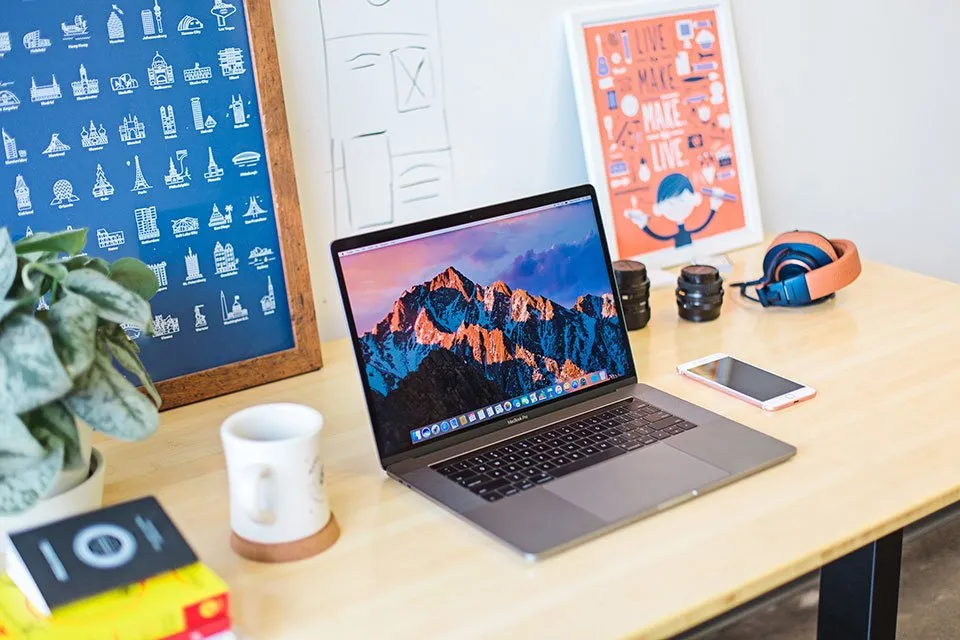Prepare to have clients rip your most prized works of art to shreds by adding their 2 cents, 5 cents and a bag of chips, until you can’t stand to work on the project any longer as it does not even make graphical sense anymore.
Yes, a graphic designer’s life can be hard at times, but I’m not writing this to rant about all the negative aspects there are to being a graphic designer (every career has its pros and cons) I am writing this to tell you that it truly is a wonderful career choice.

Photo by Mia Baker on Unsplash
If you are thinking about studying to become a graphic designer you will definitely have some exciting days ahead of you. The assignments given in graphic design courses are generally fun and quite different to most courses. They are designed to make you think outside of the box, which is an important frame of mind to be in, especially for people that will most likely land up working on brand advertising campaigns in one way or another.

Photo by Alice Achterhof on Unsplash
Don’t be surprised if your course assignments request you to paint, draw and sketch with traditional media such as oil paint, pencils, pens, pastel crayons or even charcoal. A course I enrolled for back in the day started with traditional media for the first half and then progressed to digital media. First in the form of having to paint, digitally, over the traditional media artwork you created and then later completely digital from start to finish.
The idea was for the students to understand that the mouse and computer screen is just an extension of their creativity the same way a brush, paint and canvas is or a hammer, chisel and rock for that matter. I will always cherish that course and the information I learned through it – mostly the fact that the lecturers truly did make me rethink everything I thought I knew about graphic design. So to you, the reader, I want to say, if you are considering a career in graphic design, GREAT! Open your mind, prepare to learn new, exciting things and practice, practice, practice!
A graphic designer can never practice enough.

Photo by Ali Yahya on Unsplash
I would advise you look online for tutorials on using design software such as Photoshop, Illustrator, InDesign etc. You really need to do as many of these tutorials as you possibly can. My courses were great in laying a solid foundation, but the honest truth is, where I learnt the most practical knowledge that I apply at work on a daily basis is from internet tutorials. There is no shortage of awesome tutorials online. Search Youtube and Pinterest. Visit Tutsplus.com and search abdozeedo.com for psdtuts. Please prepare yourself for doing a lot more work than your course material requests of you!
Start seeking out clients early on

Photo by Headway on Unsplash
You should try to start taking on odd jobs for people as early on as possible. Reach out to family and friends to help connect you with business owners or company managers who might need some design work done. If you don’t know how exactly to do what they require, Google it. If they don’t end up using what you designed, don’t worry about it, carry on, soon someone will.
The reason I advise you start early is because I feel that courses don’t always prepare students for working with clients. I see it all the time, graphic design interns that don’t know how to handle rejection. Clients are straight forward, critical and picky. You need to learn how to let criticism roll off your back and skillfully steer the client in the right direction.
Keep up with the latest trends

Photo by NordWood Themes on Unsplash
It is extremely important for graphic designers to be in tune with the latest trends before the masses follow. Today’s client is very well informed, they do their research before they meet with you and if you’re in a meeting where a client constantly has to explain which trend they are referring to and what it is then you are not going to come across as the knowledgeable graphic artist they are looking for. It is so easy to keep up though, so don’t fall behind for no good reason. Subscribe to design blogs, follow the famous artists on Twitter and arrive at work/campus 30 minutes earlier to grab a cup of coffee/tea while you read through the latest happenings in the digital art world.
Follow your passion

Photo by Greg Rakozy on Unsplash
Some design jobs can actually be boring. I know of a friend of a friend who studied for 3 years, passed with distinctions and landed a great job at a well-known newspaper in town. He ended up mostly having to lay out pages filled with text columns over and over again. He loathed the work so much that he not only quit the job but the entire career too.
I myself landed quite a unique and exciting job designing socks a few years back. Yup, sock designing is a thing :) It was fun at first, but I eventually grew tired of it and I moved on. The important thing I’m trying to say is; move on if you feel you need to. There are so many different directions you can go into as a graphic designer. Try to do some research on this before or while you are studying to give yourself better clarity on which type of career you would want to pursue and if you end up feeling bored, move on! Don’t get me wrong, I’m not saying you should quit your job that easily, please do make sure you line another job up before quitting the one you have. All I’m saying is; don’t get yourself stuck where you feel a lack of inspiration, because graphic designers feed off of inspiration.
Most importantly, have fun!

Photo by Anthony Ginsbrook on Unsplash
If you’re not having fun you’re doing something wrong! Sure, not every single day is going to be a blast, it is a job after all, but if you don’t feel excited at least somewhere during the phase of a project then a career in graphic design might not be for you. Please don’t fall into the trap of thinking you need to stay where you’ve decided to be, there are so many other directions a graphic designer can move into without having to learn a complete new career. Take Front-end (UI) development for example. I moved from graphic design to UI development later on in my career. I taught myself HTML and CSS so that I could design websites as well as code them for browsers!
Whatever you do, stay inspired and keep learning!
I hope that I was able to shed some light on a few things that some career orientation guides might not discuss. I know that I would’ve valued this type of information when I was still a student. If you have any further questions please don't hesitate to ask me in the comments section.
Thank you for reading
Sincerely, @BegToDiffer